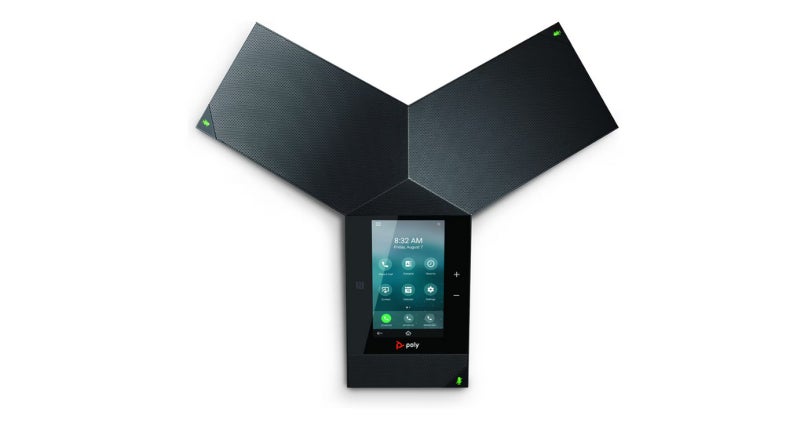
A good conference phone is 100% worth the investment. The right conference phone ensures that participants aren’t struggling to hear each other, repeating themselves, or wasting time adjusting the device during calls. All the conference phones I recommend are compatible with most VoIP platforms, and some even support PSTN calls, although you might need additional equipment for that.
Here’s everything you need to know to find the best VoIP conference phone for you.
Every conference phone makes it possible to participate in audio meetings; however, they come in a wide variety of sizes, with various ports, daisy chain capabilities, and ranges. Here’s a detailed comparison of the main differences between my top picks of VoIP conference phones.
| Best for | Price | Power source | Daisy chain | Ports | |
|---|---|---|---|---|---|
| Poly Trio 8800 | Best overall | $320-$913 | PoE Type 4 | Up to 3 | 1 USB 2.0-A, 1 USB 2.0 Micro-B, Bluetooth 4.0, 10/100 Ethernet |
| Cisco 7832 IP | Small meeting rooms | $395-$600 | PoE Type 2 | No | 10/100 Ethernet |
| Polycom Trio 8500 | Midsize meetings | $140-$200 | PoE Type 4 | No | 2 USB 2.0, 1 10/100 Ethernet, 2 RJ9 |
| Konftel 55Wx | On-the-go meetings | $100-$475 | Battery | No | 1 USB 2.0 Mini -B, 1 RJ11, 3.5 mm headset, Bluetooth |
| Yealink CP960 | Large conference rooms | $300-$720 | PoE Type 4 | Yes | 1 RJ45 10/100 Ethernet, 2 MIC, 2 USB 2.0, 1 3.5mm audio, 1 USB 2.0 Micro-B, 1 security slot, Bluetooth |
| Konftel 300Wx | Versatile meeting environments | $350-$800 | Battery | Yes | 1 USB 2.0, Bluetooth, RJ9, RJ-45 |
The Poly Trio 8800 stands out as the go-to VoIP conference phone, blending cutting-edge tech with user-centric design. With its swipe-and-tap touchscreen and bright five-inch display, diving into call controls and settings is a breeze. And with mics that catch sound in a full circle and pick up sound up to 20 feet away, everyone’s voice is heard clearly, even in large meeting spaces.
Poly Trio 8800 audio is top-notch thanks to Polycom’s HD Voice and Acoustic Clarity tech. Conversations sound clear and natural, without annoying echoes or background racket cutting in. Its adaptability is a big plus, too. It can work with up to three different systems simultaneously and can handle two lines on the same system. That means it plays well with all sorts of setups, from SIP services to office PBXs.
Preconfigured devices directly from your VoIP provider are the easiest way to go, but it’s also more expensive than buying the device elsewhere and configuring it yourself. Where you buy it from has a major impact on how much it will cost.
| Pros | Cons |
|---|---|
| Massive 20-foot range. | More expensive than others. |
| Daisy chain up to three additional devices to cover large rooms. | Could be overkill. |
| Huge vibrant display with touch screen and gesture controls. | |
| Compatible with Apple Airplay and Miracast. | |
| Works with a huge range of VoIP platforms and providers. |
The Cisco 7832 IP conference phone really shines in smaller meeting spaces where clear and smooth communication is key, without the need for all the bells and whistles. Its stylish look not only brings a dash of modern flair to any room but is also built for easy handling, making those conference calls as comfortable as chatting on your mobile.
The straightforward monochrome screen gets you all the info you need at a glance, from caller ID to quick feature access, streamlining your call handling without fuss. When it comes to sound, this device packs a punch for its size. It offers crystal-clear audio that makes every conversation feel like a face-to-face chat, free from annoying echoes or interruptions. It also comes equipped with all the essential call control features and tight security to keep your discussions private. As simple as it may be, the Cisco 7832 doesn’t cut corners on what matters.
The Cisco 7832 IP phone is compatible with a ton of VoIP providers, but not many of them sell it directly. Webex is one of the few exceptions. As with others, pricing varies widely depending on where you buy it.
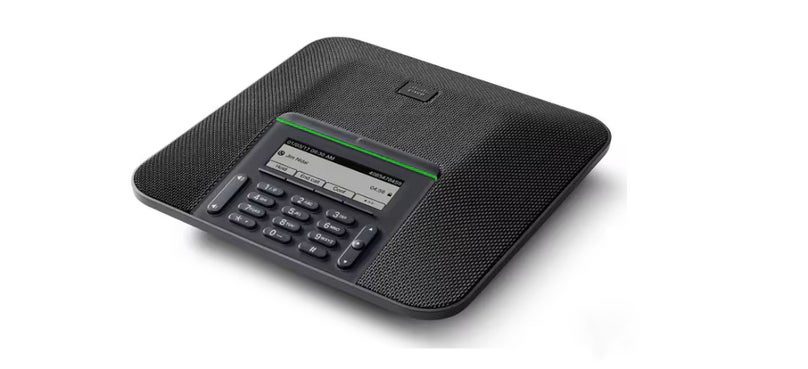
| Pros | Cons |
|---|---|
| Very easy to set up and use. | Doesn’t work with Wi-Fi. |
| Simple and streamlined for small meetings. | Display is monochrome and not a touch screen. |
| More microphones than others. | No option for daisy chaining. |
| Affordable without sacrificing quality. | |
| Seamless integration into Cisco environments, but also works with other providers. |
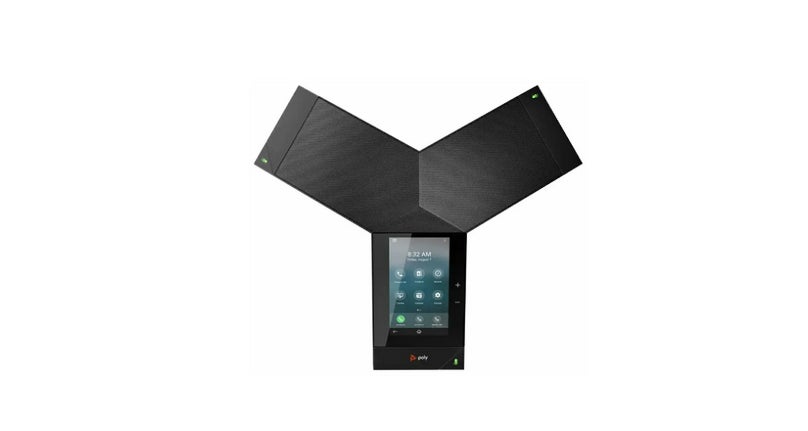
| Pros | Cons |
|---|---|
| Strong noise reduction and cancellation capabilities. | No battery, which limits its portability. |
| Compatible with various VoIP platforms and providers. | Not available directly from most VoIP providers. |
| Intuitive interface and easy setup. | No daisy chaining. |
| Two USB ports for connecting other devices if needed. | |
| Vibrant 5” touch screen display. |
The Konftel 55Wx is perfect for teams of 10 to 15 people who need a reliable conference phone for small to medium-sized rooms. Its top-notch OmniSound HD technology delivers crystal-clear calls, making sure everyone’s voice is heard loud and clear.
The phone’s compact design, combined with its ability to connect to just about anything — be it your computer, smartphone, or regular desk phone — makes it versatile and a great fit for all sorts of meetings. What’s more, the Konftel 55Wx is designed to make your life easier. Its rechargeable battery will keep your meetings going even if there’s no outlet nearby, and it’s easy to move around since it’s cord-free. The bright-color touchscreen is also a great feature, so controlling your calls is straightforward, which everyone can appreciate.
Like the Poly Trio 8500, this device isn’t regularly sold directly from VoIP providers. It’s compatible with a lot of them, but you’re more likely to find it from a third-party seller.
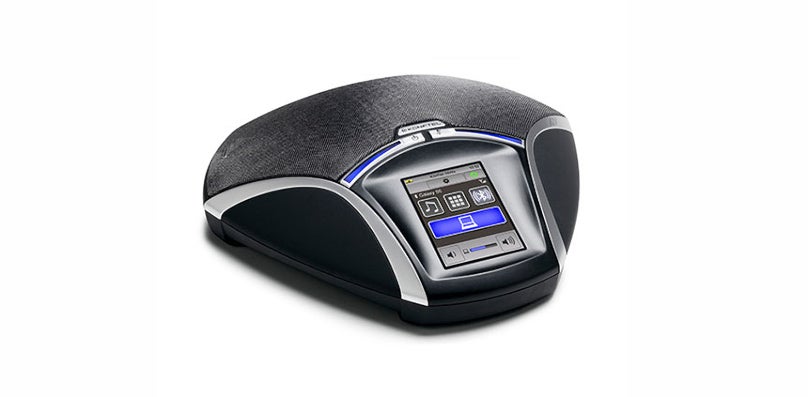
| Pros | Cons |
|---|---|
| Uses a rechargeable battery, making it versatile and portable. | Outdated USB port. |
| Easy to set up. | Doesn’t support PSTN calls. |
| Decent 14-foot range. | Smaller screen than others. |
| More affordable than other options. | |
| No chords or anything else to get in the way. |
The Yealink CP960 conference phone is a fantastic pick for bigger meeting areas, comfortably accommodating 15 to 20 people. It offers Yealink’s top-notch HD audio and noise-canceling tech, ensuring every conversation is heard clearly. Thanks to its trio of microphones, the mic picks up sound from up to 20 feet away and can catch voices from any direction, so no one gets left out of the conversation.
The CP960 is a pro at connecting however you’d like. It’s great for VoIP calls through a USB, making Bluetooth connections to phones, or even hooking up to computers for those important Skype meetings. And with its high-res touchscreen, navigating through options and managing calls is easy.
This device is not sold directly through most VoIP providers, so you’ll have to get it from a third-party seller and configure it yourself.

| Pros | Cons |
|---|---|
| Huge range and fully extendable as needed. | More expensive than others. |
| Built-in Wi-Fi and Bluetooth capabilities. | Overkill for regular conference rooms. |
| You can connect it directly to your computer for videoconferences. | Not sold by most VoIP providers. |
| Optimized for large rooms. | |
| Great noise cancellation. |
The Konftel 300Wx is a winner for big meetings, easily accommodating more than 20 people with room to spare. What really sets it apart is its OmniSound® tech, which ensures every single word is crystal-clear. This means that in big meeting spaces, everyone’s heard just like they’re right next to you.
Beyond its audio capabilities, the Konftel 300Wx also impressed us with its adaptability across various digital platforms. Whether it’s linked to computers for VoIP calls, connected to smartphones via Bluetooth for mobile conferences, or integrated with traditional desk phones, this conference phone offers unparalleled versatility. This flexibility goes even further with its compatibility with leading collaboration tools such as Microsoft Teams, Cisco Webex, and Zoom, making it an indispensable asset for businesses utilizing a hybrid meeting model.
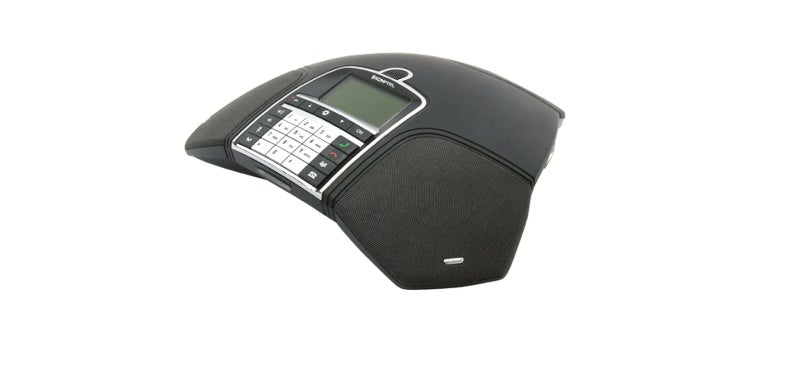
| Pros | Cons |
|---|---|
| Massive 60 hours of call time between charges. | Requires a compatible DECT system. |
| Portable and versatile, making it easy to move around and use in various situations. | Pricey in comparison. |
| Built-in noise suppression and cancellation for a wide range of environments. | Advanced features may require expertise to set up. |
| Extendable with microphones and daisy chaining if needed. | |
| Compatible with a ton of platforms. |
The most important consideration is the size of your conference room. If you typically handle audio conferences by yourself in a closed office, the phone you pick doesn’t matter too much as long as it fits within your budget.
But for larger spaces with multiple people attending in the same location, it makes a major difference.
Other than that, I suggest paying close attention to the power source, available ports, and extendability as well as the manufacturer’s overall reputation.
I meticulously sifted through a variety of VoIP conference phones, focusing on their performance, features, size, and how well they support meetings of varying capacities.
My review process included an in-depth look at technical specifications alongside real-world user feedback to ensure these devices stood up to the demands of modern-day conference calls.
Specifically, I looked at: